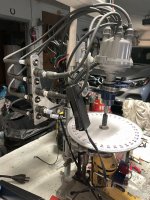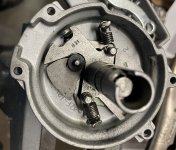I was messing around with this thing the other day and couldn't figure out why the advance readings I was seeing on my degree wheel maxed out at such a low value (I was seeing maximum advance at the numerical value stamped on the slotted part).
It was then explained to me that I was reading the advance on the distributor, not at the crank. To explain and (hopefully) clarify, the timing marks are on the crankshaft, which spins twice as fast as the camshaft and distributor. So the degrees of advance seen on my degree wheel will actually be half of what would be seen on the crankshaft marks. Doing this will provide resonably accurate numbers for the distributor mechanical advance curve.
Something to keep in mind if you build one of your own.
It was then explained to me that I was reading the advance on the distributor, not at the crank. To explain and (hopefully) clarify, the timing marks are on the crankshaft, which spins twice as fast as the camshaft and distributor. So the degrees of advance seen on my degree wheel will actually be half of what would be seen on the crankshaft marks. Doing this will provide resonably accurate numbers for the distributor mechanical advance curve.
Something to keep in mind if you build one of your own.
Last edited:



